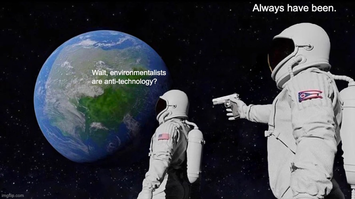
For some reason, an increasing number of writers seem surprised to discover that environmentalists are anti-technology.
Last week, Josh Barro excoriated “coalitions of NIMBYs and Malthusian environmentalists working together to block the transmission lines we need to bring clean electricity to major cities so we can burn less coal and natural gas.”
“Faux environmentalist Left-NIMBYism is emerging as a substantial threat to decarbonization,” as Bloomberg economist Noah Smith recently put it.
These critiques are well deserved by the institutional environmental organizations blocking clean energy infrastructure. But they share one major flaw. Environmentalism has not been corrupted by “Malthusian environmentalists,” its aims “weaponized” by NIMBYs who take anti-technology stances in conflict with environmental goals.
Quite the contrary, environmentalism is Malthusian and anti-technology to its core.
Consider the so-called IPAT formula, which has been used for decades to illustrate environmental impact:
Impact = Population x Affluence x Technology
In this formulation, population (P), affluence (A), and technology (T) are definitionally bad for the environment. It’s an analytically powerful tool, used by the UN Intergovernmental Panel on Climate Change to decompose the drivers of global carbon emissions into population, wealth, energy intensity of the global economy, and carbon intensity of global energy supply.
IPAT suggests a stark tradeoff between human wellbeing and environmental sustainability. And while it’s true that larger populations and greater wealth have been associated with ecological devastation, this assumption also reflects the ideology of one of the IPAT formula’s creators: Paul Ehrlich, author of the 1968 book The Population Bomb and probably the most prominent living Malthusian. Ehrlich famously predicted widespread overpopulation and death from famines (both of which never came to pass) and advocated coerced sterilization campaigns in Asia and elsewhere.
Another of the formula’s creators, Barry Commoner, an early proponent of “limits to growth” and the concept of “sustainability,” argued that “the environmental crisis is somber evidence of an insidious fraud hidden in the vaunted productivity and wealth of modern, technology-based society.”
If you think these are archaic, fringe views, consider the third and final creator of the IPAT formula: John Holdren, founder of the Energy and Resources Group at UC Berkeley, former President of the American Association for the Advancement of Sciences, and chief science advisor to President Barack Obama.
Even beyond IPAT, anti-technology, anti-growth, anti-humanist thinking was the rule, not the exception, among the originating thinkers of environmentalism. Rachel Carson, author of Silent Spring and the unofficial founder of modern environmentalism, wrote that “chemicals are the sinister and little-recognized partners of radiation in changing the very nature of the world, the very nature of its life." David Brower left the Sierra Club to found Friends of the Earth because the Club demonstrated insufficient opposition to the Diablo Canyon nuclear power plant in California (which Friends of the Earth, the Natural Resources Defense Council, and, yes, the Sierra Club are all still trying to shut down today). The Brundtland Report, the foundational text of sustainable development, concluded that “a low energy path is the best way towards a sustainable future.”
Perhaps these views were more understandable in the postwar economic boom, the infancy of environmental scholarship, and the abrupt arrival of whole new classes of technology in energy and food systems. . The 20th century was, in relatively short order, rocked by accelerating population growth, rapid “catch-up” economic expansion all over the world, booming dense cities, and previously unimaginable technological achievements, like organochloride pesticides, nuclear radiation, and transgenic modification. The environmentalist overcorrection was, if not defensible, comprehensible.
Read the rest of this piece at Breakthrough Institute.
Alex Trembath is Deputy Director at Breakthrough.












